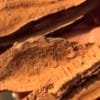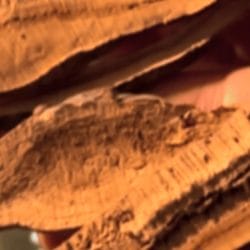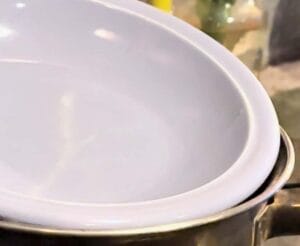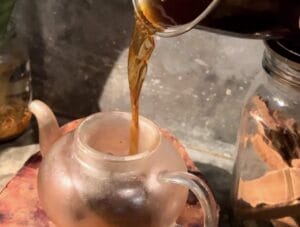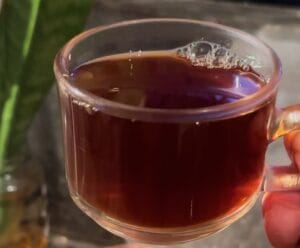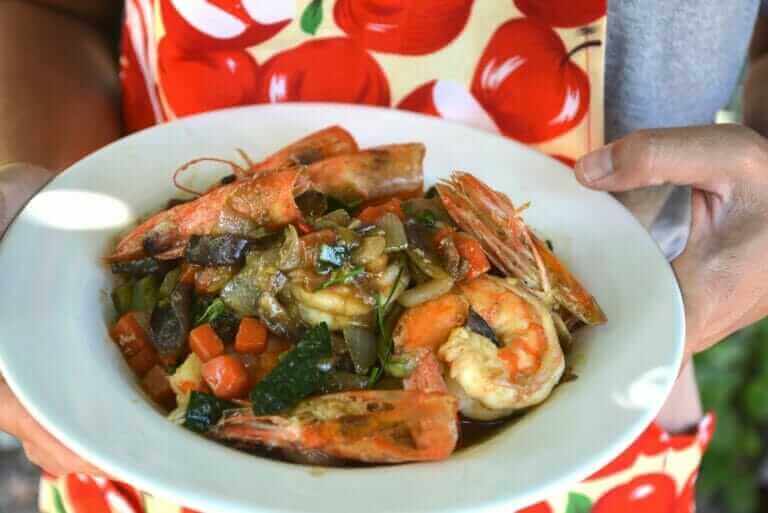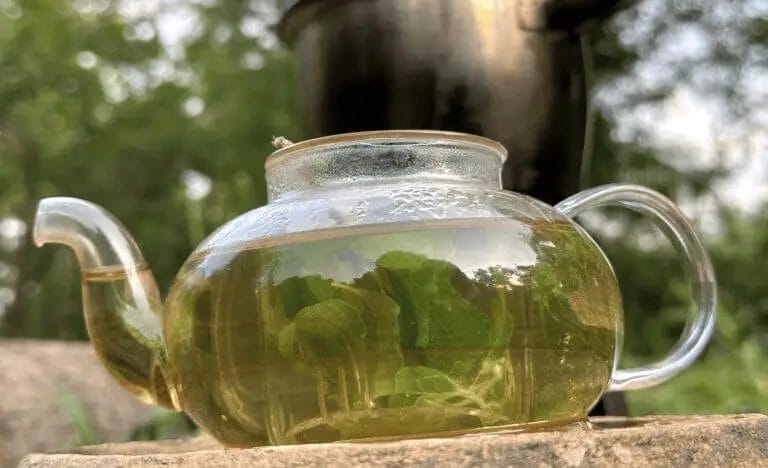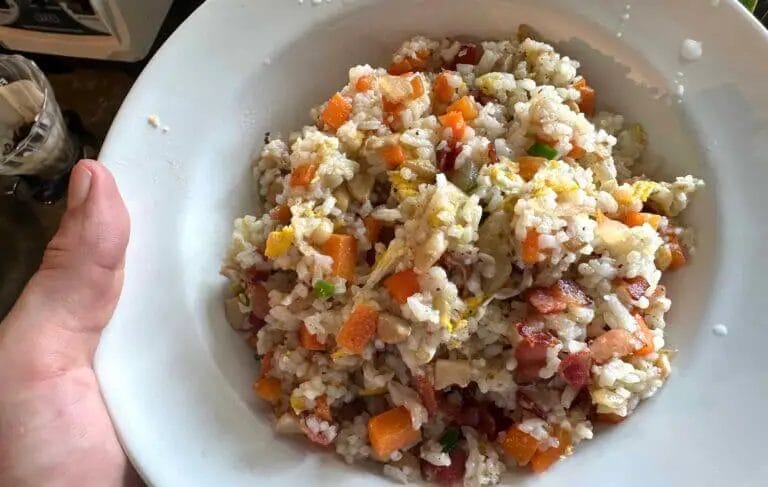Sproutingfam.com is supported by its readers. If you purchase through a link on my site, I may earn a commission. Learn more
Reishi Mushroom Tea Recipe – Made With Dried Ganoderma lucidum (Lingzhi)
Learn how to make Reishi tea with this Ganoderma lucidum Reishi Mushroom Tea Recipe.
It’s actually a decoction, a more intense version of making tea.
So this recipe decocts dried Reishi mushroom by simmering it long enough to extract its beneficial compounds into the water.
In hopes of quelling a months-long bout with systemic inflammation due to hidden black mold poisoning in an AC living in the tropics, my search of potential triggers led me to a number of foods and herbs I should be consuming during this time to support my body while I heal my gut and get this chronic inflammation attack handled.
Reishi mushrooms all but topped this list of amazing potential food-medicines that will help. Holy basil tea was another. Tea and tinctures are the two ways to benefit the most from Reishi. I share some done for you extracts under the decoction recipe as well.

Why Should You Learn How To Make Reishi Tea?
This Reishi Tea Recipe (aka Lingzhi or Red Reishi mushroom) is a 1-hour decoction of dried and sliced Reishi mushroom. Click here to jump straight to the step-by-step instructions section.
This tea is an everyday drink that can support your overall wellness longterm. That’s why we should all learn how to brew Reishi tea.
Let’s dive a bit deeper though, before going into the decoction brewing recipe instructions.
Below is more information about these mushrooms and their potential benefits to our mind and body.
What Are Reishi Mushrooms?
Reishi, also known as Ganoderma, is the name for this genus of wood decay polypore fungi that grow throughout coastal China, Japan, Korea, Taiwan, North America and other parts of the world. It is a big, glossy mushroom that is called lingzhi in China and mannentake in Japan.
Reishi (Ganoderma) is also native to North America, where you’ll find them growing on decaying logs and tree stumps in places such as the Pacific Northwest or parts of the Appalachians.
There is a similar yet lesser-prized Gano species that looks like the treasured Ganoderma lucidum (Reishi or Lingzhi) in North America. It’s the Ganoderma curtisii and is often found on Hemlocks.
G. lucidum is the most revered of the medicinal Gano mushrooms. It’s most often found growing in Asian tropics, but I hear you can find them growing on Oaks in the U.S.
G. lucidum is also called Red Reishi.
Reishi (Ganoderma lucidum), are also known as Lingzhi, are the most well-known today due to their use in ancient Chinese medicine. But all Ganoderma species have been and can be used medicinally.
This Ganoderma lucidum species has varieties, each having their own unique medicinal value.
The one that is most used and revered is the Red Reishi (this recipe), the Ganoderma lucidum var. lucidum.
So its variation name is the same: lucidum.
Then there are other Gano lucidum variations
One of them named Ganoderma lucidum var. sinense is called Zizhi in China where it is found.
This G. sinense variation of G. lucidum is so similar to Lingzhi/Red Reishi (G.lucidum var. lucidum) that many products marketed as Red Reishi are actually a powdered form or extract of G. sinense (Zizhi).
Both Lingzhi and Zizhi were used medicinally in ancient Chinese medicine, but there is a difference between the two. And there are likely lesser-known Reishi species and variations of Gano lucidum in the east Asian tropics.
Variations of G. lucidum include:
- Ganoderma lucidum var. resinaceum
- Ganoderma lucidum var. tsugae
- Ganoderma lucidum var. parvulum
- Ganoderma lucidum var. atropurpureum
- Ganoderma lucidum var. caeruleum
- Ganoderma lucidum var. rubra
What is Reishi Tea?

This Reishi tea is a Reishi mushroom decoction.
A decoction is an ancient method of extracting water-soluble properties from plants or fungi with low heat and extended periods of time. This is opposed to infusions or teas.
It is not really a tea in the truest form of the word, because teas usually don’t get simmered for an hour before consuming.
Instead, with Reishi, you get a potent bitter-in-a-good-way drink that may be just what your body needs!
Benefits of Drinking Reishi Tea
In the oldest ancient Chinese materia medica there is available to the public called the Shen Nong Ben Cao Jing, or “The Divine Farmer’s Classic of Materia Medica in English,” Reishi is classified as a “superior herb” or “upper class herb.”
It is divided into three scrolls that document three distinct groups of herbs: 120 ‘upper’ (Ϟ shang) herbs, which can be taken daily to lengthen the lifespan; 120 ‘middle’ (Ё zhong) herbs, which can be taken to prevent and hold back illness; and 125 ‘lower’ (ϟ xia) herbs which treat illness, are mostly toxic and should not be taken for a long time.
– The Alternative Clinic
Ancient Chinese medicine factors in your unique constitution and only TCM professionals can prescribe herbal medicine.
All the “upper” herbs wouldn’t work for all people. This is something to consider. So you should consider the risk for a certain number of people that wouldn’t take to this “upper” classified fungi.
If Reishi does suit you, then it’s one of the upper herbs that can be taken daily to ‘keep diseases at bay, help with deficiencies, or lengthen your lifespan.
Upper plants prescribed in quantity and/or prescribed for a long time will not injure the person, use if one desires to lighten the body, benefit qi and lengthen the lifespan.
– JulieAnn Nugent-Head translation from First Materia Medica
A note about upper classified herbs is they’re said to be the most safe-to-consume.
Some of these safe benefits Reishi offers include:
“…tonifying effects, enhancing vital energy, strengthening cardiac function, increasing memory, and antiaging effects. According to the State Pharmacopoeia of the People’s Republic of China (2000), G. lucidum acts to replenish Qi, ease the mind, and relieve cough and asthma, and it is recommended for dizziness, insomnia, palpitation, and shortness of breath.
– From Ch. 9 Section 2 of Herbal Medicine: Biomolecular and Clinical Aspects. 2nd edition.
How To Attain Reishi’s Other-Worldly Benefits
If you’re wondering how to use dried Reishi mushroom, decoctions and tinctures are the two best ways.
- Reishi decoction (this recipe) – use water to extract its water-soluble compounds
- Reishi tincture – use 80 proof alcohol (40%) or higher to extract its alcohol-soluble compounds
- Reishi extract supplements – You can buy high quality encapsulated Reishi extract supplements as well.
Real Mushrooms and Oriveda are two good brands that I will also update this post to share more about..
Of the two Reishi extraction methods (water, alcohol), each extracts their own sets of beneficial compounds.
A dual-extraction combines both the decoction and tincture at a specific ratio at the time of consumption.
The dual-extract would provide you the widest spectrum of active beneficial medicinal mushroom compounds.
Does Reishi Mushroom Tea Taste Good?
In the world of herbalism, bitter is good and sweet is bad.
If we’re going by this, then I see why Reishi is nicknamed the ‘Mushroom of Immortality’.
It’s not so bitter that you can’t drink it, but it’s almost that bitter.
If you infuse your Reishi decoction in other herbs, it helps lessen the bitter blow. Miracle fruit season would be perfect for some Ganoderma tea.
This recipe here infuses the decoction with green tea.
Stevia leaves could also help mask the bitterness.
Any bitterness is short-lived. It doesn’t impact you and come back to haunt you like a spoonful of blackpepper seed oil does.
How To Make Reishi Tea: 7-Step Decoction Recipe

First things first, the amount of mushroom to use.
How Much Reishi Mushroom To Use
Dosage will be based on your preference and personal needs, It comes down to getting your desired strength of the decoction.
A general recommendation is 5 grams of dried Reishi per 4 cups of water (32oz or a quart). These 4 cups of water become 1 serving of Reishi mushroom tea.
If you want 2 servings, use 8 cups with 10 grams.
*This recipe’s images show 15 grams of dried Reishi slices with around 1000mL water. I do not recommend you decoct 15 grams unless specifically prescribed by your TCM doctor or another healthcare professional.
For this Reishi mushroom tea recipe, I recommend decocting the suggested 5 grams if you’re just going at it for yourself and are interested in trying it out..

Equipment
- Medium-sized pot with lid
- Tea strainer of some sort
- Mug or tea pot
Ingredients
- 5 grams of dry and sliced Reishi mushroom
- 1 Tbsp Green tea leaves or herbs of your choice *optional
- 4 cups of water
Reishi Tea/Decoction Brewing Steps
Step 1. Heat Up Water In Pot
Get a quart of water to boil on a pot or saucepan.
Step 2. Weigh Out Reishi
For 4 cups of water, 5g of dried Reishi mushroom slices.
Step 3. Prep Reishi & Add To Pot
While the water heats up, break up your dried Reishi mushroom slices into the water. The more you smash or pulverize the easier it is to extract from.
Step 4. Lower To Simmer For 1-Hour

Once your water hits the boiling point, bring it down to a simmer if possible.
You can extract a good amount from a 30-minute simmer, but I recommend going the whole hour.
Step 5. Make Sure To Put A Lid On The Pot

In order to trap the volatile oils that will escape from your decoction otherwise, you must put a lid on your pot. I broke my glass lid, so here you see I’m using a plate. The key is to leave a crack to let the steam out.
Step 6. Infuse With Other Herbs

I poured it into an earlier brewed green tea and then added some stevia.
Step 7. Strain Then Relish In Reishi Greatness!
Pour the finished decoction liquid through a tea strainer of some sort to remove any bits and pieces that will come when pouring.
If you’ve broken it up into larger chunks you can just pour it straight into a mug without anything really getting in. This is more for if you’ve broken it up into tiny pieces.
Recipe finished.

Enjoy it while warm, or chill and drink it cool.
Either way, it’s not one to sip on for the enjoyment, but for the medicinal value.
Like with tea, hot or cold Reishi drinks both deliver the goods we seek.
Notes On How To Make Reishi Tea
- Make sure you low simmer because a low boil will have your water evaporate before the hour is up if you walk away (low boil would still give you a good decoction, but a simmer is better at extracting its nutrients)
- You may water to try simmering for 30 minutes instead of the full hour the first time you make it, just in case an extremely potent elixir may deter you from obtaining what it provides.
- It goes without saying, but please consult your healthcare provider before starting to drink Reishi mushrooms tea. If you have health conditions or are taking a medication that it can interact with, you’ll want to be extra careful.
Reishi Mushroom Tea Recipe (Decoction) Box
Equipment
- 1 Steel Pot with Lid or glass pot with lid for boiling water
- 1 Tea Pot Or tea strainer of any sort
- 1 Cup to drink from
Ingredients
- 5 grams Reishi mushroom dried, sliced
- 4 cups water
Instructions
- Get your 4 cups of water heating up to a boil
- While it heats up, weigh out ~5g of Reishi
- Take your weight out Reishi and break it into pieces by hand into the water as it is heating up.
- Once it hits the boil, lower to a simmer or as low of a boil as possible.
- Put a lid on as soon as you get to your simmer and leave it for an hour, checking the water-level occasionally.
- Blend with other herbs once your decoction is ready to mask bitterness. Use the decoction once done, while hot, to immediately thereafter infuse with additional herbs in your preferred method of infusing.
- Enjoy! You may want to drink it fast as it's not the most pleasing beverage to consume.
Notes
- There is a chance your water is going faster than it should, and if so you’ll want to lower the heat or turn it off and consume a shorter brew time decoction.
- You can also add some water, depending on how long it’s been and what level it’s at.
Thanks for coming to the Sprouting Fam blog!
Let me know if you have any questions, comments or critiques about this Reishi decoction.
Next: An Easy, Natural Cinnamon & Clove Mouthwash Recipe

